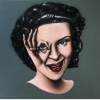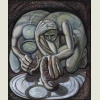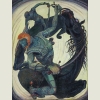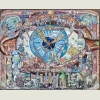Alexander Rodin and contemporary art
Belarusian artist Alexander Rodin is both a representative of neo-avant-garde and an "ole good" painting school - narrative and figurative. There are a number of performances and videos under his belt, but brushes, oil and canvases remain his best friends. Of course, almost 95 percent of Belarusian art innovators live through their self-actualization periods with the aid of the traditional process layout (stretcher - canvas - oil) and bearing the classic art forms in mind. But even in comparison with the artists of similar background, Rodin's works astonish by the immense volume of the laborious manual process - literally every inch of canvas is scrupulously refined. Oil, sometimes with the help of a ruler, is applied in tiny separate strokes, repeating the mechanical discoveries of divisionism. Such creative method is most of all akin to the work of jeweler - the surface of painting is polished as a precious stone - accurately and intricately. Taking into account the sizes of Alexander Rodin's paintings, which sometimes reach three or even four meters, this meticulous technique can be truly considered as an astonishing feat. Although it is in some ways surprising, since neo-avant-garde movement historically holds the certain distrust of anything that is connected with the craftsmanship of artist. The domination of the concept over the technique is one of the essential qualities of contemporary art. It turns out that most contemporary artists try to boggle the mind of spectator by the certain stylistic action, which as it often happens by no manner of means is the element of their workmanship, but is more like their trademarks. Therefore the work of art can be identified as a poetic declaration, which is recurred in works of a particular artist but despite of its "obviousness" we, since being ignorant, don't notice this pattern. There is no doubt that all this Rodin's large-scale handiwork must have an imminent goal. It must precede something significant or lead to it, must indicate some enormous meaning.
The art of Alexander Rodin is a multifaceted mix of the biomorphic and technical, the reminiscences of classical fine art and achievements of avant-garde, evidence of the past and futuristic forecasts - and the distinctiveness of each of these components is vivid and not dispersed. And movement images are always present in his works - sailboats, aircrafts, rockets, water- or visual images, means of monitoring. For example, the gigantic eye, swarmed all over by objects like Noah's ark before its departure. A someone, who is impetuously turning a handle of vintage movie camera. Being engaged in all this, you experience the intriguing impression of a presence in the world of some systems or codes, not read or not understood to the end. Here the past, future and present are interlaced together.
And all of it is the model of the Universe.
It's a concept, absolutely phenomenal and bright, which represents an exquisite anachronism among fashionable and flossy narrative "tongue-tie".
In Rodin's art there is a great variety of objects that appeal to different periods of civilization and culture. They create the sensation of being in the world of obsolete artifacts, which no one is going to use anymore, but they are valuable because of their previous functionality and the underlying thoughts - and we can even absorb their beauty. Contemporary art usually doesn't take into the consideration the past but Alexander Rodin grasps it, having a knowledge of history of art. No doubt he is a man of taste, because the most important in quotation is to find the method of visualization. And here the sensation, that certain events or forms have been reflected, is transmitted as simple as possible. This can be noticed in disproportionally small and fragile figures of lions, sphinxes and images of buildings and ships, which are scattered illogically here and there like abandoned porcelain toys. That doesn’t leave the impression of the reality of facts and events that once took place, but rather the presence of some transcendent knowledge that vanished or was lost by humankind, the knowledge about worlds and cultures that used to exist or was never real.

Alexander Rodin. Take That. Oil on Canvas. 2005. 90cm x 120cm
As a matter of fact contemporary art is not carried out by futuristic vision either where, besides anarchic fantasy, the persuasiveness and the hang of an argument are required. The fantasy is needed, which is practically impossible without significant portion of the real workmanship involved. Therefore, prediction of our "would-be" future has become a prerogative of movie industry or video art where computer technologies have opened nearly infinite opportunities. Alexander Rodin's vision of the future is at the same time the result of his foresight and intuition, almost scientific forecast and the logical and illogical course of events. The topic he defined as cosmology. It is supported technically in very convincing manner, has obvious apocalyptic nature and in the end makes extremely strong impression. To some extent all this is a bit fear-provoking and undoubtedly includes Durer’s patterns, but to a far greater degree in Rodin's works you can observe almost childlike artist's passion and enjoyment of all these explosions, artillery and free falls.

Alexander Rodin. Free Fall. Oil on Canvas. 140cm x 100cm
The mediator between the past, present and future is the upward tendency of time but in Rodin's art it ceased quite abruptly. The time itself did not disappear, but it suddenly became real at all stages at the same time. And events have lost their natural logic. The "would-be" future has become the part of the present and coexists side by side with the past. Feeling of the free spontaneity of events is represented nearly on a physical level. It manifests in the frenzied dispersion of different characters and objects all over the canvas and in the powerful stratification of events, complex forms that create the impression of something integral and staggering. It's pointless to straighten anything out. The linear flow of time doesn't exist, it runs in a circle and remains in the form of perpetual rotation, therefore the main thing is the harmony of already occurred, present and future events, forms, objects and phenomena. The world is brought to the forefront in its active and passionate phase. It is this passionate sensation that reveals the secret of abovementioned Rodin's mastership. There would be no place for such intricate and thorough performance if the artist lacked deep warmth towards subjects and characters of his paintings. If it's an apocalypse, then it is a buoyant one.
Clearly, the technical mastery of the Belarusian artist is similar to the process of meditation, when enormous efforts are directed to something that invariably lacks of practicality. Taking into account seriousness and depth of Alexander Rodin's elaboration of each artwork (his reflection on future creative concepts has taken the shape of journaling) the act of meditation seems absolutely crucial.
Rodin's skills and technique also determine the coloristic features of his works. Having become iconic, the "classic" color scheme appears impossible and pointless. But it refers equally to the approach discovered by Suprematism that color specifies a line or a form and carries symbolism, when its power and sonority is emphasized. In Rodin's art some other qualities of color are in the lead - thin vibrations or rattle, picked out by nerve cells or an inner ear. But it is vital to emphasize that the entirety of the perception is not disrupted - the works of Alexander Rodin look quite colorific. His filigree work seems sophisticated and decorative on small canvases, but the real capacity of his technique stands out a mile on his large paintings and in large exhibition halls. In such cases Rodin's works become a vivid manifestation of usually hardly explainable art term "spaciousness".
It is important to realize that no matter how fast modern technological development is going, there are still a number of things in art, which cannot be replicated by means of technology. And it is safe to say that Alexander Rodin's creativity illustrates this fact with solid confidence. The technical methods are in the spotlight requiring more of complete presence of an artist and they seem less functional and, if you prefer, more traditional, than the ones, as we might think, that have been dumped forever.
After all, a production of video installations by itself is as routine as applying the paint with a brush. So, we probably are being at the moment of rediscovery o the actuality of a certain craftsmanship in art. "Apparently the charge of irony contained in the protest against the visual forms and also against the traditional pillars of art such as craftsmanship, is already ran down, although theoretically it is still being acknowledged", said Ugo Nespolo.
Larisa Mikhnevich,
Art critic
translation by Bella Belarus , 2008 ©
GO to Alexander Rodin's main page






